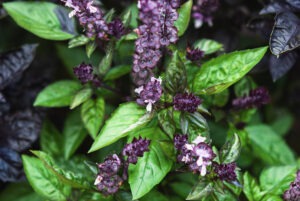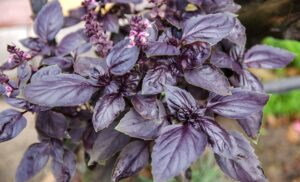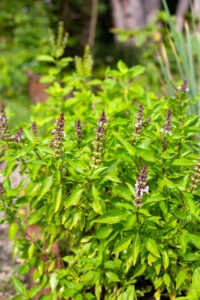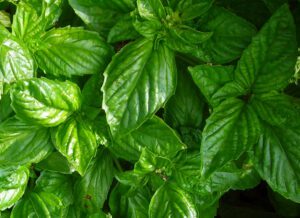There are estimated to be between 50 and 150 distinct species and varieties of basil. While many culinary varieties are cultivars of Ocimum basilicum (sweet basil), others come from different basil species, such as Thai basil, purple basil, and holy basil.
Popular Basil Varieties for Your Garden:
Genovese Basil (Ocimum basilicum ‘Genovese’):
Genovese, or Italian basil, is perhaps the most popular basil variety for cooking. Its large, shiny, rounded leaves are a staple for many chefs and gardeners. Known for its superior quality in pesto and as a raw addition to salads, it’s a must-have for culinary enthusiasts.
USDA Zones: 9 to 11

Sweet Basil (Ocimum basilicum):
Sweet basil is similar to Genovese basil, but with a milder and slightly sweeter flavor, sometimes with a hint of anise or licorice.
USDA Zones: 9 to 11

Thai Sweet Basil (Ocimum basilicum var. thyrsiflora):
A favorite in Thai cuisine, Thai sweet basil has a flavor that holds up well under high cooking temperatures, making it ideal for stir-fries and curries.
USDA Zones: 9 to 11

Cinnamon Basil (Ocimum basilicum ‘Cinnamon’):
Known as Mexican spice basil, cinnamon basil offers a mild, spicy flavor with cinnamon undertones. It’s a popular addition to various Asian dishes.
USDA Zones: 9 to 11

Lemon Basil (Ocimum basilicum citriodorum):
Also referred to as Thai lemon basil or hoary basil, this variety has a refreshing lemony flavor combined with the classic basil taste. It’s commonly used in South Asian cuisine.
USDA Zones: 9 to 11

Osmin Purple Basil (Ocimum basilicum ‘Osmin Purple’):
Osmin purple basil is one of the most popular purple basil varieties. Its flavor is bold and spicy, with clove-like notes.
USDA Zones: 9 to 11

Greek Basil (Ocimum basilicum var. minimum ‘Greek’):
One of the smallest basil varieties, Greek basil grows well in containers and makes an attractive garnish, perfect for adding a fresh touch to dishes.
USDA Zones: 9 to 11

Holy Basil (Ocimum tenuiflorum):
Also known as tulsi, holy basil has a spicy flavor and is a key ingredient in Indian cuisine. Beyond its culinary uses, it is also highly regarded in traditional Indian medicine for its medicinal properties.
USDA Zones: 9 to 11

Napoletano Basil (Ocimum basilicum ‘Neopolitan’):
Native to Naples, Italy, Napoletano basil boasts a strong and sweet flavor. It’s also known as lettuce-leaf basil due to its large, broad leaves.
USDA Zones: 8 to 11











